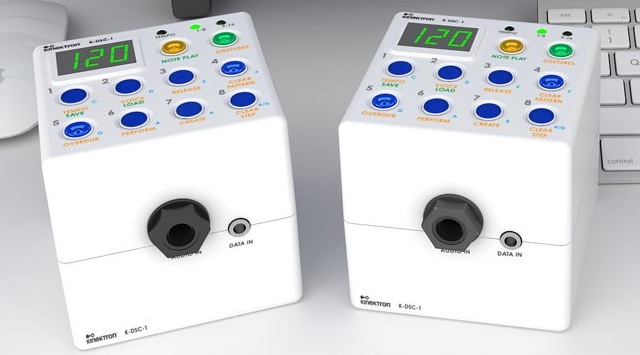On of the more interesting introductions from the 2012 Summer NAMM Show is the Kinektron Digital Synth Cube, a small self-contained synthesizer & sequencer.
Newly-formed company Kinektron is introducing its first piece of synth gear, the K-DSC-1 ‘Digital Synth Cube’. Featuring a self-contained general MIDI synthesizer engine and 16-step step sequencer, the device is, according to its developers “a unique entry level music making machine.”
Features:
- Self-Contained general MIDI synthesizer engine and 16-step step sequencer
- Similar in programming workflow to classic step sequencer based equipment such as x0x boxes and similar analog or early digital step sequencers
- Gestural controls enabled by built in accelerometer
- Unique, Infrared programmability – program your K-DSK-1 from any web enabled computer or mobile device which supports java and a minimum refresh rate*
- 8 Patterns at a time
- 32 Voice Polyphony
- Pattern Save\Recall
- Several Programmable Parameters for each step
- MIDI sync and other MIDI features will be available via planned expansion module
- No menu items deeper than 2 button presses.
- Easy color-coded interface is intuitive to learn with little study
- Web based pattern sharing and creation with our unique ‘light based’ pattern programming protocol, K-IRP.
- Hidden game will become playable as more modules are collected (and firmware updates are distributed)
The Kinektron Synth Cube System
The Kinektron Synth Cube is intended to be part of a larger, open ecosystem.
The K-DSC-1, by itself, is a compact, portable, ‘semi-pro’ music production and sound experimentation kit. In addition to the initial module, though, Kinektron has several additional modules in development:
- The K-ASC-1 Analog Synth Cube;
- The K-APM-1 Analog Percussion Module;
- The K-DSP-1 Digital Signal Processor; and
- A MIDI interface\audio mixer cube, the K-MAMC-1 MIDI & Audio Mixer Cube. The K-MAMC-1 will allow syncing of Kinektron Synth Cubes with standard MIDI equipment.
K-Konnect ‘Open Protocol’ Interface
Kinektron has also developed an Open Protocol, K-Konnect. With auto-negotiation, bi-directional, master-less communication, and other features, this protocol is what connects the various cubes together.
Kinektron plans to provide example code to allow Arduino, Parallax Propeller, and similar micro-devices to interface and communicate with K-Konnect devices.
The Kinektron Digital Synth Cube
 The most unique feature of the Kinektron K-DSC-1 Digital Synth Cube is the use of a primarily gestural parameter entry methodology, along with a simplified 16 property editing grid, with properties being selected by first pressing one of two mode switches and then tilting the cube to enter parameters.
The most unique feature of the Kinektron K-DSC-1 Digital Synth Cube is the use of a primarily gestural parameter entry methodology, along with a simplified 16 property editing grid, with properties being selected by first pressing one of two mode switches and then tilting the cube to enter parameters.
Another unique feature is the ability of the K-DSC-1’s ‘K-Connect’ data ports to be used easily with Arduino micro controller boards – popular programmable single board computers. Kinektron plans to offer a library, example code, and tutorials to create projects with the K-DSC-1 and an Arduino board at product launch.
The unit also features a built in digital delay and a transistor distortion, reminiscent of classic FX pedals, each with step-sequenced parameters.
The Digital Synth Cube was created by Robert Guyser and Glen Liberman.
Kinektron expects the Digital Synth Cube to be priced under US $200 and to be available sometime in early 2013. In the meantime, they’ve got a papercraft model of the Digital Synth Cube (.pdf).
See the Kinektron site for additional details.


An “XoX” sequencer with only a handful of buttons sounds like a total PITA….
How many buttons do you think you need?
One per step?
Can you imagine programming this thing, with only a 3 character LCD, and buttons to step through each step of the pattern?!
Zymos – I haven’t worked with this sequencer – so it may be a PITA!
But I’ve worked with other step sequencers that use two buttons to navigate you left and right through the sequence and then two buttons to shift the notes up or down. Add a toggle for on/off/hold and another for glide and you can do a lot.
Note what it says in the article, too, that you can tilt the cube to adjust the continuous parameters. That might be an easier way to enter pitches.
I think it could be that the 8 buttons are the note on steps and you hit function to get the other 8 while things like velocity or pitch will be determined by how you position it in space.
I think it seems cool and I hope it actually gets released.
The only thing that worries me though is that they use “analog” in the promotional material. Digital synthesis is capable of way more radically expressive sounds and the analog folks will never be happy with anything. Gimme wavetables, additve, fm and samplers!
Go for it Mosher!
This looks interesting – but I’d like to hear an example of what this can do or see a demo. The GM soundset is a red flag for me. How much programability does this have?
This thing is awesome! I for one am very excited about having a highly portable sequencer. I like the idea of having my sequencer and Synth module on on one table space, i have modules that i would love to just set a small sequencer next to and work on sound design, of course this would entail a midi out or some sort of function like that. Spoke to these guys at naam, they are really excited to make this project stand out as a new type of production tool. I wonder what the synth itself will be like.
It’s a unique, seemingly well priced and fairly well executed idea, but the biggest question remains:
How does it sound?
One of the cutesy synths to date xD
General MIDI sound set. Probably Yamaha QY-70 for 200$ has more power